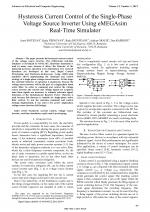| 3/2015 - 14 |
Hysteresis Current Control of the Single-Phase Voltage Source Inverter Using eMEGAsim Real-Time SimulatorBOTEZAN, A. |
| Extra paper information in |
| Click to see author's profile in |
| Download PDF |
Author keywords
hysteresis current control, voltage source inverter, real-time simulation, rapid control prototyping
References keywords
power(35), active(19), filter(14), control(14), phase(12), electronics(9), current(9), shunt(6), implementation(6), single(5)
Blue keywords are present in both the references section and the paper title.
About this article
Date of Publication: 2015-08-31
Volume 15, Issue 3, Year 2015, On page(s): 99 - 104
ISSN: 1582-7445, e-ISSN: 1844-7600
Digital Object Identifier: 10.4316/AECE.2015.03014
Web of Science Accession Number: 000360171500014
SCOPUS ID: 84940752190
Abstract
The paper presents the hysteresis current control of the voltage source inverter. The eMEGAsim real-time simulator is developed by OPAL-RT. Real-time simulation is used in many cases because it allows the behavior of the industrial processes operation to be determined. Two research directions are developed in this case, Rapid Control Prototyping and Hardware-In-the-Loop. Using eMEGAsim simulator allows implementing the command and control strategy of a single-phase voltage source inverter. At this stage, the real-time behavior of operation is monitored, because the voltage source inverter will be the part of a single-phase shunt active filter. In order to command and control the voltage source inverter, the current and voltage signals are acquired, since these signals are necessary to estimate reference signal. Extension of the Instantaneous Reactive Power Theorem is used because this theorem is suitable for single-phase active filter control. To test the real-time command and control strategy implemented, it was used a low power single-phase voltage source inverter (full bridge). |
| References | | | Cited By |
Web of Science® Times Cited: 1 [View]
View record in Web of Science® [View]
View Related Records® [View]
Updated today
SCOPUS® Times Cited: 2
View record in SCOPUS® [Free preview]
View citations in SCOPUS® [Free preview]
[1] An investigation of Grid-Integrated Photovoltaic system intended for hybrid Moth Flame Optimization using ANFIS techniques, Rajagopal, Sureshkumar, Umapathy, Prabha, Journal of Intelligent & Fuzzy Systems, ISSN 1064-1246, Issue 3, Volume 42, 2022.
Digital Object Identifier: 10.3233/JIFS-211748 [CrossRef]
Disclaimer: All information displayed above was retrieved by using remote connections to respective databases. For the best user experience, we update all data by using background processes, and use caches in order to reduce the load on the servers we retrieve the information from. As we have no control on the availability of the database servers and sometimes the Internet connectivity may be affected, we do not guarantee the information is correct or complete. For the most accurate data, please always consult the database sites directly. Some external links require authentication or an institutional subscription.
Web of Science® is a registered trademark of Clarivate Analytics, Scopus® is a registered trademark of Elsevier B.V., other product names, company names, brand names, trademarks and logos are the property of their respective owners.
Faculty of Electrical Engineering and Computer Science
Stefan cel Mare University of Suceava, Romania
All rights reserved: Advances in Electrical and Computer Engineering is a registered trademark of the Stefan cel Mare University of Suceava. No part of this publication may be reproduced, stored in a retrieval system, photocopied, recorded or archived, without the written permission from the Editor. When authors submit their papers for publication, they agree that the copyright for their article be transferred to the Faculty of Electrical Engineering and Computer Science, Stefan cel Mare University of Suceava, Romania, if and only if the articles are accepted for publication. The copyright covers the exclusive rights to reproduce and distribute the article, including reprints and translations.
Permission for other use: The copyright owner's consent does not extend to copying for general distribution, for promotion, for creating new works, or for resale. Specific written permission must be obtained from the Editor for such copying. Direct linking to files hosted on this website is strictly prohibited.
Disclaimer: Whilst every effort is made by the publishers and editorial board to see that no inaccurate or misleading data, opinions or statements appear in this journal, they wish to make it clear that all information and opinions formulated in the articles, as well as linguistic accuracy, are the sole responsibility of the author.



